Green House Gases In Atmosphere










Green House Gases In Atmosphere
Greenhouse Gasses in Atmosphere: The greenhouse effect is the process by which absorption and emission of infrared radiation by atmospheric gases warm a planet's lower atmosphere and surface. Naturally occurring greenhouse gases have a mean warming effect of about 33°C (59°F), without which Earth would be uninhabitable. Rather, the issue is how the strength of the greenhouse effect changes when human activity increases the atmospheric concentrations of some greenhouse gases.
On Earth, the major greenhouse gases are water vapour, which causes about 36-70% of the greenhouse effect (not including clouds); carbon dioxide (CO2), which causes 9-26%; methane (CH,), which causes 4-9%; and ozone, which causes 3-7% of the greenhouse efect. Molecule for molecule, methane is a more effective greenhouse gas than carbon dioxide, but its concentration is much smaller and its total radiative force is only about a fourth of that from carbon dioxide. Some other naturally occurring gases contribute very small fractions of the greenhouse effect; one of these, nitrous oxide (Na0), is increasing in concentration owing to human activity such as agriculture. The atmospheric concentrations of CO, and CH, have increased by 31% and 149% respectively since the beginning of the industrial revolution in the mid-1700s. The IPCC Special Report on Emissions Scenarios gives a wide range of future CO, scenarios, ranging from 541 to 970 ppm by the year 2100
Students / Parents Reviews [10]
A marvelous experience with Abhyas. I am glad to share that my ward has achieved more than enough at the Ambala ABHYAS centre. Years have passed on and more and more he has gained. May the centre flourish and develop day by day by the grace of God.

Archit Segal
7thAbhyas is a complete education Institute. Here extreme care is taken by teacher with the help of regular exam. Extra classes also conducted by the institute, if the student is weak.

Om Umang
10thAbout Abhyas metholodology the teachers are very nice and hardworking toward students.The Centre Head Mrs Anu Sethi is also a brilliant teacher.Abhyas has taught me how to overcome problems and has always taken my doubts and suppoeted me.

Shreya Shrivastava
8thAbhyas Methodology is very good. It is based on according to student and each child manages accordingly to its properly. Methodology has improved the abilities of students to shine them in future.

Manish Kumar
10thMy experience with Abhyas academy is very good. I did not think that my every subject coming here will be so strong. The main thing is that the online tests had made me learn here more things.

Hiya Gupta
8thIt has a great methodology. Students here can get analysis to their test quickly.We can learn easily through PPTs and the testing methods are good. We know that where we have to practice

Barkha Arora
10thBeing a parent, I saw my daughter improvement in her studies by seeing a good result in all day to day compititive exam TMO, NSO, IEO etc and as well as studies. I have got a fruitful result from my daughter.

Prisha Gupta
8thMy experience with Abhyas is very good. I have learnt many things here like vedic maths and reasoning also. Teachers here first take our doubts and then there are assignments to verify our weak points.

Shivam Rana
7thOne of the best institutes to develope a child interest in studies.Provides SST and English knowledge also unlike other institutes. Teachers are co operative and friendly online tests andPPT develope practical knowledge also.

Aman Kumar Shrivastava
10thI have spent a wonderful time in Abhyas academy. It has made my reasoning more apt, English more stronger and Maths an interesting subject for me. It has given me a habbit of self studying
